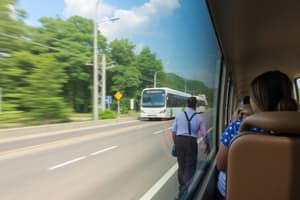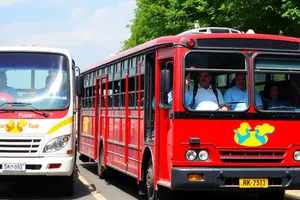Podcast
Questions and Answers
Which factor is LEAST likely to influence a tourist's choice of transportation?
Which factor is LEAST likely to influence a tourist's choice of transportation?
- The type of meals served onboard. (correct)
- The transport service's safety record.
- The unique experiences involved in the transport
- The convenience that the transportation choice will provide.
Passenger transportation only involves moving people, and not conveying them to a preferred destination.
Passenger transportation only involves moving people, and not conveying them to a preferred destination.
False (B)
What term describes tourist transport that is frequently a part of a tour package, often utilizing chartered coaches?
What term describes tourist transport that is frequently a part of a tour package, often utilizing chartered coaches?
Dedicated Tourist Transport
A decline in tourism transport demand during the rainy season in the Philippines demonstrates the impact of ______ on the tourism industry.
A decline in tourism transport demand during the rainy season in the Philippines demonstrates the impact of ______ on the tourism industry.
Match the type of aviation with its description:
Match the type of aviation with its description:
The Wright brothers are credited with what?
The Wright brothers are credited with what?
The Philippines is widely known for its airplane manufacturing industry.
The Philippines is widely known for its airplane manufacturing industry.
What is the role of the Civil Aviation Authority of the Philippines (CAAP)?
What is the role of the Civil Aviation Authority of the Philippines (CAAP)?
Airlines that operate on a network structure, offering scheduled service through a hub-and-spoke system, are known as ______.
Airlines that operate on a network structure, offering scheduled service through a hub-and-spoke system, are known as ______.
What governmental body ensures both the safety and the comfort of public land travelers?
What governmental body ensures both the safety and the comfort of public land travelers?
Flashcards
Transportation
Transportation
Activity of moving goods/people from one place to another
3 Modes of Transportation
3 Modes of Transportation
Air, land, and water.
Way
Way
Natural (sea routes, airways) or artificial (roads).
Vehicles
Vehicles
Signup and view all the flashcards
Passenger Transportation
Passenger Transportation
Signup and view all the flashcards
Seasonality
Seasonality
Signup and view all the flashcards
Price elasticity
Price elasticity
Signup and view all the flashcards
Dedicated Tourist Transport
Dedicated Tourist Transport
Signup and view all the flashcards
Luxury Tourist Transport
Luxury Tourist Transport
Signup and view all the flashcards
Distance
Distance
Signup and view all the flashcards
Study Notes
- Transportation pertains to transferring goods or people from one point to another.
- Transport is a product of the travel industry.
Modes of Transportation
- Air
- Land
- Water
Components of Transportation Systems
- Surface: land and water transport
- Air: decreases tourist travel time
Elements of Transportation Systems
- Way: Natural (sea routes, airways), Artificial (roads)
- Vehicles: airplanes, cruise ships
- Terminal: decongests traffic and interference from one mode of transportation to another
- Control and Communications System
- Management and Staff
Tourism Transportation
- It moves individuals and conveys to their preferred destination, carrying people not just products
- Passenger Transportation: the movement of people regardless of the mode of transportation
- Whether by air, land, or water, it is a vital force of the tourism industry
Tourist Transport
- It is seen as the primary tourist service, and one of the most utilized service in tourism industry.
Factors That Set Tourist Transport Apart from Passenger Transport Sectors
- Seasonality: Demand differences, higher during the summer in the Philippines and decreases during the rainy season.
- Price elasticity: An increase in transportation costs could lead to a decrease in demand.
- Highly Capital-intensive: Some transport sectors are expensive, like purchasing an aircraft or ship for cruise tourism.
Categories of Tourism Transport
- Independent means of travel: Tourists book individually, typically by land transport through private car rentals
- Mass travel: Organized group tours, using chartered coaches and flights for a specific purpose
Types of Tourism Transport
- General Passenger Transport: Mainly for general travelers and not specifically for tourists.
- Dedicated Tourist Transport: Frequently included in a tour package, often chartered coaches.
- Experiential Tourist Transport: Creates an extraordinary tourist experience, e.g., kalesa.
- Luxury Tourist Transport: Offers high-quality service and comfortable travel experiences.
- Recreational Transport: Used for tourism, like hop-on and hop-off buses, attracting tourists seeking a nontraditional and fun experience
- Multipurpose Tourist Transport: Includes motorhomes, RV trailers, are in Vogue right now as well
Factors Influencing Tourism Transport Selection
- Distance: A major consideration in choosing the best mode of transport
- Schedule: Transport departure and arrival time makes it practical for tourists to choose a transport service that best fits their itinerary
- Frequency: Higher frequency gives tourists convenience, not waiting too long for the next departure
- Availability: Provides travelers with an opportunity to choose, the more transport available results in better accessing the destination
- Speed: One of the most essential considerations
- Safety and Security: A safer and more secure mode of transport is often the priority
- Convenience: A hassle-free vacation is a sought-after experience
- Unique Experience: Entices tourists to choose tourist transport services that create an exceptional travel opportunity
- Route: Affects tourist decisions in selecting the best transport, often affected by connecting flights and their layover
Considerations in Selecting Tourism Transport
- Cost: Fare or cost of transport services affects the decision of tourists
- Status and Prestige: Transport services may influence choice, e.g., business/first class or luxury transport
Air Transportation
- Youngest among all major modes of transport coming in the early 1900s by the Wright brothers with the first successful flight
- Sea and Land Travel: Has been moving man since ancient times
Aviation
- A general term from the French word "avi" meaning bird, means design, development, production, operation, and use of aircraft
- This definition covers a system that references air transportation.
Types of Aviation
- General Aviation: All civil aviation operations other than scheduled air services and non-scheduled air transport operations for remuneration or hire. It involves activities like business flights, air charter, private aviation, flight training, ballooning, paragliding, etc
- Commercial Aviation: Involves flying for business, remuneration, or hire, like scheduled flights of commercial airlines in major airports.
- Military Aviation: Done for national security, warfare, logistics deployment, and may include carrying civilians for evacuation
History of Aviation (2 Categories)
- Lighter-than-air development aircraft: Hot air balloons and airships/blimps
- C.F. Marquez: First flight on a hot air balloon in Philippine airspace at a Manila carnival on April 4, 1909
- French brothers, Joseph Michel and Jacques-Etienne Montgolfier: First successful hot air balloon in November 1783.
- Heavier-than-air development aircraft: Several personalities have contributed to the initial designs of the first successful heavier-than-air aircraft
- Leonardo Da Vinci: Artistic paintings such as Monalisa and the Last Supper, influenced aviation development and sketched flying machines such as ornithopters
- Gliders: Developed around 1853 and considered the first successful heavier-than-air aircraft
- George Cayley: British engineer who flew his glider across a small valley, being the first successful airman
- Otto Lilienthal: Studied Sir Cayley's ideas, built gliders, and flew almost 2,000 controlled flights, influencing the Wright brothers
- John Stringfellow: Designed the Aerial Steam Carriage in 1842 with William Henson with lightweight steam engines
- Lawrence Hargrave: Developed an engine powered by compressed air and fuel, creating a compressed air engine
- Samuel Langley: Designed and created pilot-less heavier-than-air crafts, achieving flight in 1896 and reaching 914 meters
- Orville and Wilbur Wright: Bicycle shop owners who successfully flew the Wright glider in 1902, achieving the first manned flight in 1903
History of Philippine Aviation
- The Philippines is known for shipbuilding not airplane manufacturing
- Aviation came to the Philippines in 1911, and commercial aviation followed with mail service delivered by Tom Gunn in 1914.
- Philippine Firsts Book: Written in "100 years of Philippine Aviation (1909-2009)"
- On Feb 27, 1911, James C. Mars flew his red devil biplane 10 miles out of Manila, being the first cross-country flight, but was not commercial
Mass Air Travel
- It was prominent around 1945 to 1960 and after World War II, tourism was used to promote economic aid and cultural diplomacy.
Categories of Aircraft
- Acrobatic Airplanes: Not restricted, with flexibility for aerobatics and stunts
- Commuter Airplanes: Multi-engine, propeller-driven, and used for short distances to small airports
- Experimental Airplanes: Amateur-built or kit-built, sometimes unmanned or used for light sport
- Light Sport Aircraft: Given a special airworthiness certificate
- Limited Airplanes: Modified or converted military aircraft, used for civilian purposes
- Normal Aircraft: Same size as acrobatic planes but approved for acrobat flights
- Primary Airplanes: Compliance with production certificate, 3 or fewer seats, and typically unpressurized
- Restricted Airplanes: Used for agriculture, surveying, weather control, and forest services
- Transport Airplanes: More than 10 passenger seats
- Utility Airplanes: Can be used for aerobatics, maximum 9 passengers plus pilot
Types of Aircraft
- Airline Guide: Has 5 Code types used in Airline include J (jet), T (propjet), P (propeller), H (helicopter), and A (amphibian/seaplane)
Routes of Air Services
- Point to point: Simple routes, non-stop and direct flights
- Hub and Spoke: Airlines use busier airports as their hub for smaller regional cities to feed their passengers also known as feeder flights
Regulatory Bodies
- Global Industry Associations Organizations: Serve as intermediaries and coordination members of airlines and countries
- International Air Transport Association (IATA): Important organization in air transportation and tourism, organized by international airlines
Significance of IATA to Air Transportation
- Involved in developing and improving the global airline industry with the air transportation sector being the most organized, attributed to IATA standards
- Economic Significance of IATA: If airlines sell below breakeven, they risk financial failure
- IATA and Travel Agents: Travel agencies are accredited members issuing tickets, sell international tickets, and provide services
- International Civil Aviation Organization: A UN specialized agency that was created to administer and govern the convention in international civil aviation
Strategic Objectives of IATA
- Safety
- Air navigation capacity and efficiency
- Security and facilitation
- Economic development of air transport
- Environmental protection.
Importance of ICAO to Aviation
- It involves in aircraft incident investigators particularly concerning international airlines
- It looks into the causes of disasters and tries to learn the reasons for mishaps
Philippine Regulatory Bodies
- Civil Aeronautics Board (CAB): A Philippine government agency ensuring the economic well-being of air transportation
- Civil Aviation Authority of the Philippines (CAAP): Tasked to secure the technical and operational aspects of the airline industry
Airline Industry
- Main movers. Traveling by air may be the most expensive mode of transport, but it is also the most convenient and fastest.
- Definition of Airline: A company that provides air transportation and is typically part of a system to operate at airports
Types of Air Carriers or Airlines
- Domestic Airlines: Operates within a country between different cities or provinces
- Regional Airlines: Operates in a geographical region
- International Airlines: Travels to destinations in more than 7 hours of flying time
Classification of Airlines
- Legacy or heritage: Airlines that started the commercial airline industries and operate with more traditional or old-school strategies
- Low cost airlines: LC are called budget airlines
- Air taxis or Air Charters: Do not provide scheduled services. The name taxi gives the notion of hiring an aircraft for private function
- Boutique Airlines: They are low-cost carriers but often mistaken. Use small airplanes
- Point to point carriers: Airlines that only service passengers from origin city to the registered destination
- Network Carriers: Operate on a network structure. Offer scheduled service through a hub-and-spoke system
- Flag Carriers: Traditionally are government-owned airlines
Trends Prior to Covid-19
- Travel Preference
- Buying Behavior
- Use of Technology
- Personalization
Trends in Air Travel Post-COVID-19
- Health and Safety
- Digitalization
- Travel Behavior
- Space Tourism: Gives travelers the experience of being an astronaut
Airport Facilities
- Serve as main gateways and first touch points for arriving international passengers
Roles of Airport
- Functions as a gateway or hub for airplanes and points of convergence where other modes of transportation meet
Parts of Airport
- Runway: Heavily paved area for airplanes use for take-off and landing
- Taxiway: Connects runways to other airport components
- Apron: Area where airplanes park in front of the terminal to load/unload passengers
- Hangar: Connects to taxiways for access to planes and is the structure where the aircraft is repaired or serviced
- Control Tower: Monitors and controls air traffic within its zone.
- Parking: Area where airport personnel and passengers park their cars.
- Terminal Building: First point of contact is in the destination, giving passengers a first impression
- Departure/Level: Where passengers travel documents are processed and immigration occurs
- Arrival area/level: Where checked-in baggage is claimed and customs is if needed.
- Airport Design: Size of the terminal consider the number of flights and passengers its caters
Passenger Activity at the Airport
- At the Departure: Check in area where passengers present themselves and their proof of reservations
- At the Arrival: Checked-in bags are brought to the arrival hall for claiming or distribution, international passengers clear customs
Airport Activities for Airport Personnel
- Landslide Operations: Ground staff and passengers face-to-face contact
- At the check-in : Ground staff check travel documents
At the Departure Gate
- Check boarding passes and travel documents
Upon Arrival
- They coordinate assistance for passengers needing special assistance
Aside Operations
- Refueling: Coordination tasks
- Parking: Airplane marshals and guidance
- Maintenance checks: Aircraft mechanics and engineers
- Cargo Loading/Unloading: on the airside of the airport
- Airport Fees can be classified into two, with Aeronautical Revenues: fees and charges and Non-Aeronautical Revenue: charged for activities and services outside aeronautical activities
Land Transportation
- "Ground transportation" that aids the people in two ways: road transportation and rail transportation
- The Republic Act of 4136, also known as the “Land Transportation and Traffic Code of the Philippines" states the laws relative to land transportation and its traffic rules
Land Transportation Background
- It went from People riding carriages to travelling in the 17th century to the use of motor vehicles in the 19th century, and advanced in modern times.
Government Agencies
- Land Transportation Office (LTO): Charged with safety and comfort of public travelers of motor vehicles
Government Agencies Task
- Land Transportation Franchising and Regulatory Board (LTFRB): Simplifies the franchising system in the land transportation industry
- Office for Transportation Security (OTS): Ensures transpiration nationwide are secured
- Toll Regulatory Board (TRB): Supervises toll facilities
- Office of Transport Cooperatives (OTC): Was created to regulate transport
- Philippine National Railways (PNR): Legislation in June 1964 to provide a nationwide railway transportation system
Light Rail Transit Authority (LRTA) & Metro Rail Transit (MRT)
- Represents various agencies in the capital that the citizens use
Major International Rail Transportation System
- Eurail: Extensive railway system and allows tourist within EU.
- TGV: Allows transit all over France
Efficient Rail Transportations In Japan and the USA
- Seikan Tunnel: A 53-kilometer railway tunnel that connects Aomori Prefecture, Honshu Island and Hokkaido
- National Railroad Passenger Corporation, Amtrak: Simply known as Amtrak, it is a corporation striving a deliver a high quality, safety, and on time rail passenger service in the United States
Kinds of Rail Travel
- Transportation Rail: Passengers in general
- High Speed: Through high speed trains
- Specialty Train: Provides super deluxe services
- Local Train: Commuter train
Other Types of Trains
- Monorail: commonly used in airports
- Cable-propelled: Includes aerial tramways
- Narrow-gauge railway: Narrower track gauge is used mainly for tourism
Studying That Suits You
Use AI to generate personalized quizzes and flashcards to suit your learning preferences.




